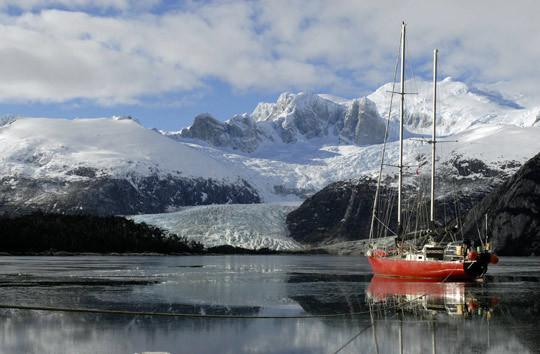
Sailor-mountaineers Greg Landreth and Keri-Lee Pashuk’s boat, Northanger, with the Cordillera Darwin in the background. The pair have sailed near the Antarctic Peninsula, Greenland and Ellesmere Island. [Photo] Keri-Lee Pashuk – Northanger Collection
Prior to the 1950s, climbing expeditions to remote peaks started with days, or weeks, spent at sea. When the French flew to Annapurna in 1950, the era of nautical travel practically ended. But some individuals still choose to combine open water and the climbing life.
Greg Landreth and Keri Pashuk are a husband-and-wife team who purchased Northanger, a 54-foot Damien II, in 1990 for use on sailing/climbing expeditions. Together they have “expeditioned” around the Antarctic Peninsula, Greenland and Ellesmere Island. They have recently evolved their plans for the boat to include “science, art and goals based on the dreams of others.”
Read more about Landreth and Pashuk’s expeditioning in Alpinist 19 and in the interview below. -Ed.
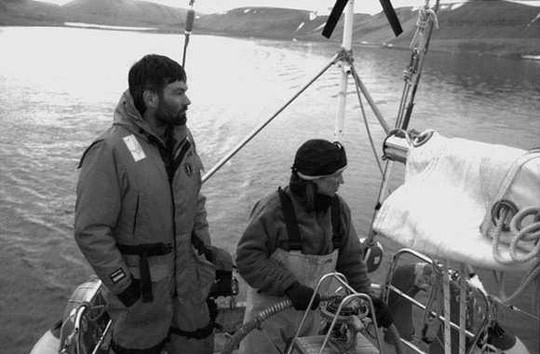
Greg Landreth and Keri-Lee Pashuk set sail from Hourglass Bay on Ellesmere Island, Nunavut, Canada. [Photo] Northanger Collection
Having been a climber long before a sailor, was there an immediate connection with sailing?
Well, it takes almost your lifetime for sailing to grow on you. Even now I can’t call myself a sailor, and even for Rick (Thomas) I think it was true. It’s just a vehicle, and I’m not really connected to the sailing world as most sailors are. We use the boat as a vehicle to get there but we’re not spiritually sailors–if there is that sort of a thing–and probably never will be.
How would you describe the relationship between climbing and sailing? Is there much common ground?
Well there is a lot of common ground, because it all takes place in the wilderness. When you’re climbing, the general rhythm is that you have an anchor–a rest–and then you scurry to the next spot to put your anchor in. And do it all over again. With sailing, you just stretch out the time scale by some years (and the expense by quite a number of zeros after the comma).
What would you consider your most memorable sailing and/or climbing achievement?
Well you can’t really separate them, I don’t think. Once you start sailing and climbing the whole thing is one fabric. Certainly my most memorable climbing achievement would have to be Smith Island. The problem is, there aren’t any more Smith Islands out there. So what we’re doing now is rather than looking at one summit in the distance and working towards that, we go along on a different journey and the mountains are the steps along the way.
Would you say you have a specific goal for your ship, the Northanger?
Our focus has really started to change quite a bit as the world changes. It has become startlingly obvious that we have to come back to something in the world that’s sustainable. We’ve started to learn that sailing to climb is not a sustainable idea at all, and we have to roll with those punches and figure it out.
Now we’re helping scientists who are on the cutting edge of discovering how we can make the whole world more sustainable, and with the idea of climbing along the way, of course.
So climbing is no longer the priority on your expeditions?
It will always form a part of it, but to get the peak above all else is not a priority anymore. The thing is, you can only expect to really climb a few major peaks in your whole life, and we have to be happy with that.
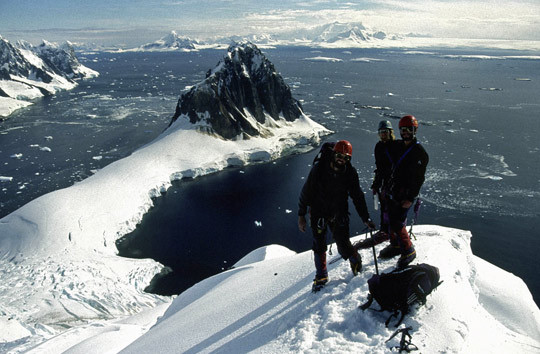
Greg Landreth, with Rich Prohaska and Jia Condon of British Columbia, pauses on the ridge leading to Wandel Peak, Booth Island, Antarctica. [Photo] Keri-Lee Pashuk – Northanger Collection
Have you seen evidence first hand of climate change in your travels?
It’s really obvious pretty much everywhere we go in Antarctica; there’s more rock exposed and more ice discharging off the front of glaciers. Having gone down there for about twenty years, which is nothing in geological time, it’s very obvious. In Patagonia we look up at places we’ve been and can see the glacier is disappearing month by month. I’ve also noticed the changing weather patterns as a sign that things are starting to warm up.
Just recently we were up in Peru having a holiday from the whole sailing thing. I went back into the mountains where I had climbed twenty-five years ago. I was hoping to climb some of the routes I’d climbed before, or at least have a look at them. I was shocked to see that many of the routes I’d climbed before didn’t have any ice on them.
We all have to protect the environment. We all have to enjoy it as well. That goes back to why the main thrust of our Northanger projects has to change.
Having been influenced by the late Rick Thomas (former owner of the Northanger) and of course H.W. Tillman, is this the beginning in the evolution of style for nautical climbing expeditions?
Yes it is. And it’s just beginning now. Quite frankly we’ve kind of lost our way in the last ten years. I think it’s because of the expense of doing what we do. We can’t really afford to do it.
We’ve been supporting other people who had goals, but didn’t have the means of getting there. That’s all very good fun and it gets the boat going and hones our skills, but it doesn’t get our own aims anywhere.
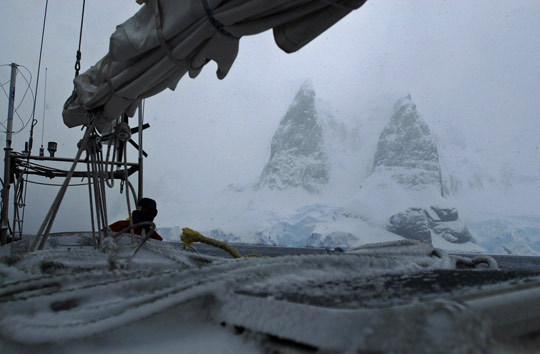
A frigid-looking day in the Lemaire Channel, Antarctica. [Photo] Keri-Lee Pashuk – Northanger Collection
What types of logistical issues do you face when packing for and supplying a sailing and climbing expedition?
There’s never enough room and never enough time. Boats are so expensive to run; when we’re out in the areas that we operate in, we have to be extremely efficient and so very safety-conscious all of the time.
And climbing is such a complex activity in itself. To successfully do it off of such a small platform that is itself at risk, is one of the most difficult things you can achieve. Anybody that can do it even once in their life deserves a big pat on the back.
When we’re on an expedition, we are basically at the end of the supply line for the whole world. To get the stuff that we need down there it takes pretty much all of our waking time. We never really know how we’re going to do it.
What is the longest amount of time that you’ve spent waiting on the boat? For how long will your supplies usually allow?
The partial answer is the twelve months we spent up in Ellesmere Island, locked in during the winter, but that wasn’t self-supported.
If we had the boat loaded to the gills and everybody was psychologically prepared for it, we could probably stay afloat for six months quite comfortably with four or five people. It would take a lot of organizing, but we could do that.
The other time I spent an extended period on the boat was when we went through the Northwest Passage with Rick Thomas, before we actually owned the boat. We were prepared for almost two years with four people. When you think about what you actually need to carry, that sort of arrangement boggles the mind. It has not been done again and probably never will be because the world has changed to accommodate re-supplies.
How difficult is it to spend that much time at sea?
You have to be pretty patient doing this sort of thing. There’s a good reason why none of these areas have been explored much. The weather is absolutely terrible, and quite frankly, it’s a crap place to take a boat because you’re always in danger. Why do I do it? I don’t think anybody can answer that.
How do you pass the downtime?
With a lot of reading and music. Keri plays the guitar and I play the cello. But you’d be surprised how little downtime there is. Whenever we get a chance to stop, we’re sort of planning for the time ahead.
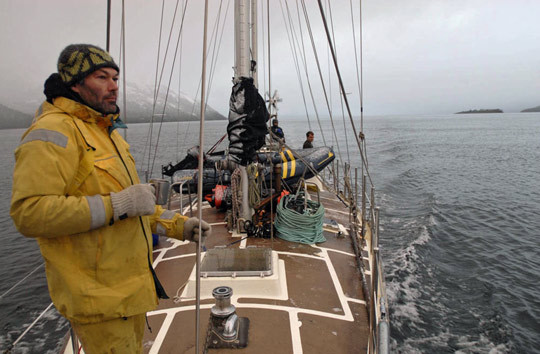
Greg Landreth and crew in the early morning. [Photo] Keri-Lee Pashuk – Northanger Collection
How well does everyone get along during multi-month expeditions?
If you put six people inside a fifty-foot steel box, and shake them around for even a couple of weeks, pretty soon you’ll figure out what a Mars mission would be like. That’s one of the major problems of the whole deal. Keri and I have figured out a way we can do that, but for most people thirty days is quite enough. However that’s not really long enough to do anything down there, so you’re always fighting cabin fever right from the start.
If it becomes obvious that your objective is not going to be reached in the first couple of weeks that’s when it gets quite tough. Even though there is a chance to reassess the objective, most people aren’t prepared to do that. Once moral starts slipping, you’re really on your back foot.
Having said that we have pretty much always achieved our objectives with the exception of our trip to South Georgia a couple of years ago and of course that’s where the accident happened where I lost my finger.
What?
Well, we were all set to support the first solo navigation of South Georgia by kayak. It took about three years to organize this thing. It was probably quite badly planned in the first stages, and the trip really didn’t have a chance of succeeding, but we just decided to go ahead anyway.
On the way to South Georgia, the boat got into a pretty major storm; it was one of those things where we just weren’t well enough prepared. I got a little too close to some revolving machinery. Suddenly I’m standing there in the middle of the ocean without an index finger on my hand. That took quite a lot of working through, even though the expedition did end up going on with Keri as the sole captain. I had to go home of course.
Looking back on it, we probably should have just scrapped the whole thing.
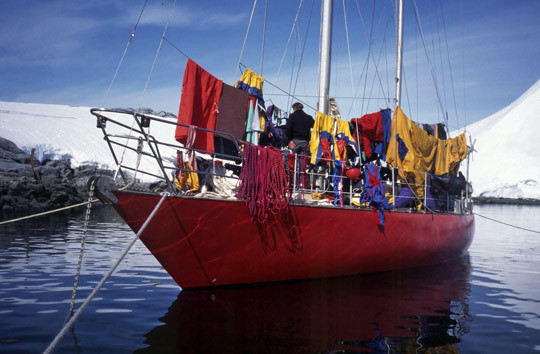
Northanger [Photo] Keri-Lee Pashuk – Northanger Collection
It must be difficult after having spent so much time, energy and money on an expedition to then have to turn around. Have there been times that you’ve pushed beyond the limits of safety?
Yes, definitely. That’s why, in the last few years, we’ve really started to think about how far we are prepared to push, and how far we will go to pursue a summit.
There are quite a few people that have started to get into this game now, and the standards of safety and reconnaissance are going down and down. Eventually they’re going to kill somebody. It appears to some to have become easier down there, but it’s not. It’s still the same big, wild Earth with some nasty mountains on it.
Which is worse, seasickness or altitude sickness?
Well, if I got seasick I wouldn’t go sailing and if I got altitude sickness I wouldn’t go off climbing big mountains. Keri gets badly seasick and she’s still out there sailing. I don’t see how she does it, but it must be worth it to her.
Seasickness is obviously something you can work through with some sort of mental stamina, but altitude sickness is something that, if you get it, you have no choice but to turn around.
Why is it mostly the British and New Zealanders who are taking on these types of expeditions and hardly any Americans?
Well as far as New Zealanders go, they’re prepared to just go out there and lace up their boots like H.W. Tillman and just do it. That’s probably why I’ve decided to do it myself, I suppose–just to give it a go. The problem Americans and Canadians have is that they have such a big back yard to play in that they seem perfectly happy staying there, and with good reason.
The other thing is that most of the stuff we do isn’t highly technical or colorful or glamorous and that’s part of the problem. In a lot of ways that sort of comes first in America. The image is really necessary.
As far as we’re concerned we don’t really care how scruffy we look out there. We just get the thing done, and pull up our trousers later on.
What’s next for the Northanger?
I don’t know exactly. We have just recently moved our home base to Chile because there have been a lot of political problems in Argentina, where we were before. We have started working to support scientific expeditions, but we don’t have any planned for this year. So what we’re going to do is sail up the Beagle Channel to the north and ski as many peaks as we can along the way.
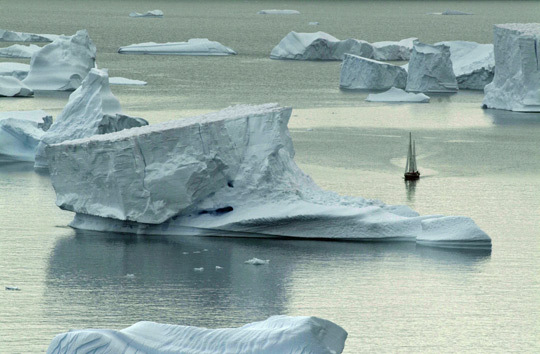
Northanger [Photo] Keri-Lee Pashuk – Northanger Collection
Click here to read the second installment in Alpinist’s Nautical Series. Click here to read the third installment in Alpinist’s Nautical Series.